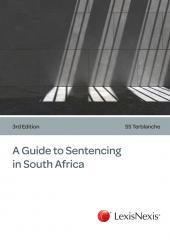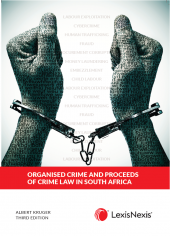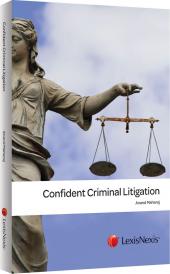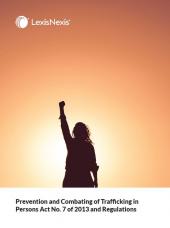A Guide to Sentencing in South Africa 3rd Edition
An invaluable guide for criminal defence attorneys, advocates, magistrates, judges, prosecutors and students.
Select a format
One Year Subscription Only Terms
Subscribers receive the product(s) listed on the Order Form and any Updates made available during the annual subscription period. Shipping and handling fees are not included in the annual price.
Subscribers are advised of the number of Updates that were made to the particular publication the prior year. The number of Updates may vary due to developments in the law and other publishing issues, but subscribers may use this as a rough estimate of future shipments. Subscribers may call Customer Support at 800-833-9844 for additional information.
Subscribers may cancel this subscription by: calling Customer Support at 800-833-9844; emailing customer.support@lexisnexis.com; or returning the invoice marked 'CANCEL'.
If subscribers cancel within 30 days after the product is ordered or received and return the product at their expense, then they will receive a full credit of the price for the annual subscription.
If subscribers cancel between 31 and 60 days after the invoice date and return the product at their expense, then they will receive a 5/6th credit of the price for the annual subscription. No credit will be given for cancellations more than 60 days after the invoice date. To receive any credit, subscriber must return all product(s) shipped during the year at their expense within the applicable cancellation period listed above.
Product description
An invaluable guide for criminal defence attorneys, advocates, magistrates, judges, prosecutors and students.
A Guide to Sentencing in South Africa is a definitive and comprehensive guide to criminal law and procedure relating to sentencing. The new edition deals with the substantial changes which have taken place since the second edition published:
The Child Justice Act 75 of 2008 has made substantial changes to the law on child justice. In addition to the new legislation, several judgments by the CC have highlighted certain legal aspects relating to children and child offenders.
There have been changes to minimum sentences, due in large part to the passing of the Criminal Law (Sentencing) Amendment Act 38 of 2007. The implications of relevant judgments by the SCA are also considered.
The correctional Services Act 111 of 1998 has been subjected to a number of amendments affecting sentencing in one way or another since 2007.
Other new or amended legislation has been included in the new edition, such as the South African Judicial Education Institute Act 14 of 2008, Prevention of and Treatment for Substance Abuse Act 70 of 2008, Prevention and Combating of Trafficking in Persons Act 7 of 2013.
The new edition also considers the development of South Africa human rights law which remains in its infancy.
Note: The online price varies according to package chosen and number of users. Our sales agents will provide a quote on request.
Table of contents
CHAPTER_1 - Introduction
The guide to sentencing
Sentencing: the neglected phase of a criminal trial
Description of terms
An academic view of the law of sentencing
Sources of sentencing
Important role players
CHAPTER_2 - Penalty clauses
Introduction
The interpretation of penalty clauses
The provisions of section 276
Penalty clauses for statutory offences
Remaining provisions of the Criminal Procedure Act
The maximum sentence
The effect of the penalty clause or the extent of punishment
Summary
CHAPTER_3 - Minimum and mandatory sentences
Mandatory sentences
Minimum sentences
Minimum sentences under the Criminal Law Amendment Act, 1997
CHAPTER_4 - Pre-sentence procedures
Introduction
A brief overview of the procedures after conviction
The central position of the court
Onus of proof at sentencing
Providing information on sentence
Dealing with previous convictions
Addressing the court
Pre-sentence reports
Absence of judicial officer
Referral of case for sentence in regional court
Plea and sentence agreements
Victim impact statements
CHAPTER_5 - The discretion with regard to sentence
Introduction
Basic principles relating to the sentence discretion
Consistency in sentencing
The application of the sentence discretion in our law
The sentence discretion: a summary
CHAPTER_6 - The general principles of sentencing
Introduction
The general principles through the cases
Finding an appropriate sentence
The demands of the time
Balance
Mercy
The sentencing judgment (giving reasons for the sentence)
The triad: the three basic elements
The “purposes� of punishment
The theories of punishment
Restorative justice
Conclusion: the current core of sentencing
CHAPTER_7 - Sentencing more than one crime at a time
Introduction
Conviction of more than one offence
Sentencing when other sentences are being served or are still in effect
Multiple crimes sharing aggravating features
The order in which multiple sentences should normally be served
CHAPTER_8 - Mitigating and aggravating factors
Introduction
Factors versus circumstances
Balancing of mitigating and aggravating factors
Factors only at the time of sentencing
Evidence
Factors which aggravate sentence
Factors which mitigate the sentence
CHAPTER_9 - Imprisonment
Introduction
Imprisonment in general
The various forms of imprisonment
Determinate imprisonment
Life imprisonment
Habitual criminals
Declaration as dangerous offender
Periodical imprisonment
Section 276(1)(i) imprisonment
Backdating of imprisonment
The aftermath of the imposition of imprisonment
Constitutional issues
CHAPTER_10 - Fines
Introduction
The purpose of the fine
Limits to imposition
The decision to impose a fine
Procedure
Execution
Payment of admission of guilt
CHAPTER_11 - Correctional supervision
Introduction
The role of the judiciary in the development of correctional supervision
Correctional supervision defined
The various forms of correctional supervision
Further aspects of the nature of correctional supervision
Distinguishing offenders
Correctional supervision as substantive sentence
The conditions attached to correctional supervision
The wording of the sentence
Following imposition of correctional supervision
The procedure in court when correctional supervision fails
The future of correctional supervision
CHAPTER_12 - Sentencing child offenders
Introduction
The Child Justice Act
The special considerations in the case of child offenders
Pre-sentence procedures relevant to sentencing
Sentencing in child justice courts
The sentences available for child offenders
CHAPTER_13 - Committal to a treatment centre
Introduction
Amendment not reflected in the Criminal Procedure Act
Limitations
The nature of the sentence
The decision to impose
Duration of sentence
Use of the sentence
Suspension
Alternative options
Procedure
CHAPTER_14 - Suspension of sentence, and related matters
Introduction
Suspended sentences
Historical overview
Postponement of sentencing
CHAPTER_15 - Caution and discharge
General
Legislative provision
The crimes for which it may be imposed
Appropriate cases for imposition
The nature of a caution and discharge
The practice
The wording of the sentence
CHAPTER_16 - Forfeiture, suspension and other punitive measures
Introduction
Forfeiture
Suspension or cancellation of a licence
Other consequences of sentencing
Closing comment
CHAPTER_17 - Compensation as civil judgment
Introduction
Statutory provision
Discussion of a few issues
Concluding remarks
CHAPTER_18 - Post-sentence procedures
Introduction
Correction of a wrong sentence
Execution of sentence when the case record is sent on review
Execution of sentence when an appeal is noted
Antedating the sentence




